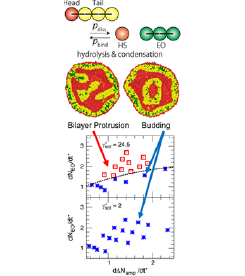Bilayer Sheet Protrusions and Vesicle Budding Induced by Chemical Reactions
Noguchi Group
In living cells, membrane composition continually changes by lipid metabolism. However, the effects of non-constant membrane composition on shape transformations of cells are not understood so well. We have studied membrane shape transformations under hydrolysis and condensation reactions using dissipative particle dynamics simulation [1]. The hydrolysis and condensation reactions result in the formation and dissociation of amphiphilic molecules, respectively as shown in Fig. 1. Because the dissociated hydrophilic and hydrophobic molecules are typically dissolved in surrounding fluids and embedded in the bilayer, we refer to them as the hydrophilic solute (HS) and embedded oil (EO), respectively.

Fig. 1. Top: Schematic picture of hydrolysis and condensation reactions. Middle: Snapshots of bilayer sheet protrusions (BP) and budding of vesicles. Bottom: Dynamic phase diagram of shape transformations for the increase rate of the amphiphilic molecular number difference, ΔNamp = Namp, out - Namp, in between the inner and outer leaflets and the EO synthesis rate dNEO/dt at high viscosity (γ*sol = 24.5) and low viscosity (γ*sol = 2) of the surrounding fluid at a low reduced volume.
Asymmetric reactions between the inner and outer leaflets of a vesicle can transport amphiphilic molecules between the leaflets via EO diffusion. We consider high HS density in the inner fluid of the vesicle and investigate how the transport into the inner leaflet changes the membrane shapes. We found that the resulting area difference between the two leaflets induces bilayer sheet protrusion (BP) and budding at low reduced volumes of the vesicles (see the snapshots in Fig. 1), whereas BP only occurs at high reduced volumes. The probabilities of these two types of transformations depend on the shear viscosity of the surrounding fluids compared to the membrane as well as the reaction rates. For high surrounding fluid viscosity, BP formation occurs at high reaction rates, but for low viscosity, budding always occurs before BP formation (see the bottom graphs in Fig. 1). In the budding, the membrane mainly moves normal to the membrane surface, but sliding between two leaflets occurs in BP formation. Thus, the viscosity of the surrounding fluids affects budding more than it does BP formation, while the viscosity in the membrane affects BP formation more. The inhomogeneous spatial distribution of the hydrophobic reaction products forms the nuclei of BP formation, and faster diffusion of the products enhances BP formation. Our results revealed that adjustment of the viscosity is important to control membrane shape transformations.
References
- [1] K. M. Nakagawa and H. Noguchi, Soft Matter 14, 1397 (2018).
